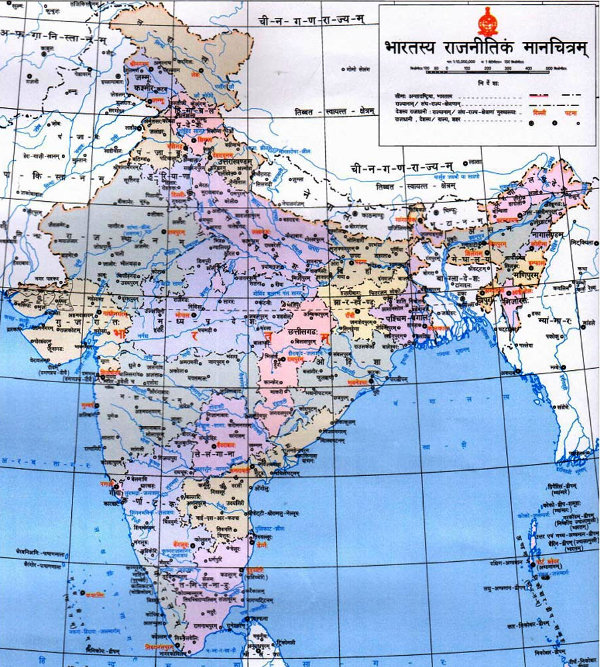New Delhi: The Survey of India has released an updated political map of India in Sanskrit language, as part of the National Science Day celebrations, the first one in 18 years.
The last time such a map was released was in 2002, when Atal Bihari Vajpayee’s NDA government was in power.
The Sanskrit and Hindi maps were unveiled on Friday at Vigyan Bhavan by Union Minister of Science & Technology, Harsh Vardhan.
Demand for a Sanskrit map
The Sanskrit map has made a comeback after being published intermittently since 1977. The Survey of India, a part of the Department of Science and Technology, had published Sanskrit maps in 1979, 1983, 1988, 1997 and 2002.
Surveyor General of India Lt Gen. Girish Kumar (retd) told ThePrint: “We have been publishing (the maps) regularly in English, and sometimes in Hindi. Now I want to regularly bring out these maps in all the regional languages, and since Sanskrit is an ancient language, we should definitely support it.”
He added that there is a demand for Sanskrit maps for exhibitions and events, especially in the Hindi belt, while organisations and institutions in Haridwar and parts of Uttar Pradesh also keep asking for them.
Usually, the Survey of India publishes only state maps in regional languages, according to demand.
Deputy Director at the Survey of India, Pankaj Mishra, pointed out that a lot of administrative changes had taken place since the last Sanskrit map was published in 2002.
“Last November, the English map was unveiled, and it generated a lot of interest. People were then looking for versions in other official languages, for helpdesks and exhibitions,” he said.
“Nowadays, even our printing systems are digital. So, it is not that difficult anymore to produce these maps in any language. We will make physical prints of the maps according to the demand.”
Names of states and cities in the new map
Most of the names of cities and states are the same as in Hindi, with additional Sanskrit suffixes of ‘am’ and ‘ah’. Rajasthan, for example, is shown as ‘Rajasthanam’, Punjab is called ‘Punjabah’, Kerala is ‘Keralam’, while Karnataka is ‘Karnatakah’.
Even the English-suffixed Nagaland has been Sanskritised by adding just an ‘am’ — the map calls it ‘Nagalandam’.
The new union territories of Ladakh and Jammu & Kashmir are given as ‘Laddakhah’ and ‘Jammuh Kashmirah’.
City names follow a similar pattern — Mumbai and Kolkata remain as is, ‘Dillih’ and ‘Chennaih’ feature minor Sanskritisation, while Gangtok becomes ‘Gangatokah’.
The map also marks water bodies like rivers and reservoirs — the river names, being mostly Sanskrit-derived, remain pretty much the same, while the reservoirs are marked as ‘Govind Sagarah’, ‘Nagarjunah Sagarah’,
The map even Sanskritises neighbouring countries and their cities — ‘Afghanistanam’, ‘Pakistanam’, ‘Islamabadah’ and ‘Peshawaram’. China is marked as ‘Cheen-Ganrajyam’ (literally, China republic), while the region of Tibet is called ‘Tibbat-Swayatt-Kshetram’, the equivalent of Tibet Autonomous Region, as China calls it.
However, the map also features some faux pas, such as referring to lakes as ‘jheelah’—such as the ‘Sambhar-jheelah’ in Rajasthan and the ‘Mansarovar-jheelah’ in China. The Sanskrit word for lake is ‘sarovar’ or ‘sar’, while ‘jheel’ is a Hindi word.
Source: OdishBytes
Image Courtesy: The Print
You may also like
-
India Can’t Afford to Remain Stagnant at this Juncture, Says PM Modi; Asks People to Buy Locally-Made Goods
-
Stolen Artefacts to be Returned to India from Scotland Museums
-
Netaji’s Hologram Statue at India Gate
-
10th Century Stone Idol of Goat Head Yogini IllegallyRemoved from A Temple in Lokhari, Banda, UP Being Returned to India
-
UNESCO Inscribes ‘Durga Puja in Kolkata’ on the Representative List of Intangible Cultural Heritage of Humanity
